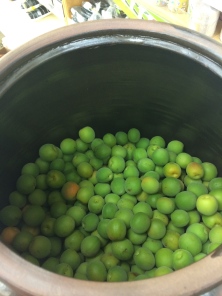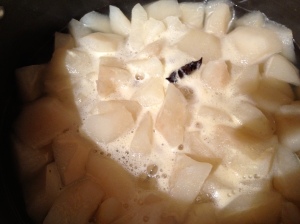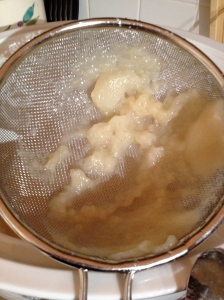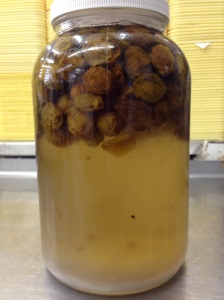Sometime in May, yeah I should have started blogging earlier, a customer comes in excited about buying 매실 (maesil) from Assi Plaza in Niles. Maesil to me means Japanese Plum, but I was proven wrong today through Wikipedia. This fruit is called a Chinese Plum or a Japanese Apricot….I think I will just stick with calling a Japanese Plum cause the liquors are sold as Plum Wine. Anyways, in Korean, it is called “maesil,” in Japanese, “ume” and in Chinese, “meizi.” The fruit itself is small, maybe 1 inch tall and about 2/3’s inch wide. The color should be like a light green to green.
Going back to the story, she was excited about buying the fruit to make an extract. I got really interested in the whole making process and got a few of the employees interested in too. A few days later, I landed myself a 25 pound box of maesil that costed me about $8 a pound (yikes, I know, this is pricey but I got wholesale price compare to the retail price of $10~$20 bucks for the early bird buyers at Assi Plaza and H-Mart), and 3 employees split a 25 pound box. Time for PROJECT MAESIL.
What You Need:
1. Maesil
2. White Sugar (Do not use Brown Sugar…something about them having their own natural scent that doesn’t work well with the maesil, I forget the rest)
3. Container with a lid that is big enough to hold your batch
What to Do:
1. Wash the fruit and let it dry completely (my mom suggested overnight).
2. Remove the ends (leaves and fuzz) with a toothpick (I didn’t do this cause I was told later about this but just for you, the reader, I found out that if you use a toothpick, the ends that have tiny leaf particles and fuzz that can be easily removed).
3. OPTIONAL: Remove all the imperfect ones, one employee said something about having a tear on the skin of the fruit that isn’t good but I forget why (to tell you something funny, when I washing my batch I found one maesil that had a teeth mark on it…guessing someone was really interested in the taste after they found out it was selling for $8 a pound…I just ended up cutting that part off and using everything whether prefect or not).
4. Here comes the tricky part, cause I heard a lot of different things, in your container (I used a 황아이, the traditional clay jar) add 1 scoop of maesil to 1 scoop of sugar. The ratio should be 1 to 1 (some have interpreted this as 1 to 1 pounds but I was told scoops…yes, the sugar would be too much due to the mass difference but I don’t think it is wrong cause I, too, thought it was too much when filling up my clay jar and somewhere in the middle, turned to 2 scoops of maesil for 1 scoop of sugar and then switched backed to the 1 to 1 at the end and added a few more scoops to completely cover my batch with sugar…my pounds ratio ended up being 25 pounds of maesil to 28 pounds of sugar).
5. Close your container with the lid and let it sit for about 90 days (yup, you heard me, 90 days…also, place in room temperature).
6. Remove the maesil and store it for another 6 months (yes I know, it’s a long process when you can go buy it at a Korean store in those 12 oz cans).
Other Notes / Comments:
In your container, the sugar will melt to liquid form with that and juices from the maesil (this smells really good too). This will eventually turn into an extract and the maesil will shrivel up.
Since I used a 황아이 (clay jar, forgive me if I spelled this wrong in Korean), after one week I noticed that the sugar have melted and mold had already started to form. Then two days later, the mold grew way too much so that I got yelled at by my mom (who was out of town and returned by then). We removed the moldy ones and separated our batch into 5 different glass jars, so eventually they will all taste differently.
The mold formed because the maesil(s) would rise to the surface after the sugar had melted down. With air and/or moisture in the jar, mold can happen because this is sitting in room temperature. Tips I heard was to put water in zip lock bags (water packets, double the zip lock if you feel like they will leak cause you don’t want any water going into your batch) and place them on top of your batch after you first see the signs of sugar melting and plums rising. This water packets will float, pushing the maesil down, and preventing it from rising to the surface (one employee tried the water packets but still found her maesils to come to the surface on the edges and formed molds, so you have to completely cover the whole surface of your batch with water packets).
What my mom and I did with our separated batch was that we refrigerated them to prevent any more maesils to grow mold. I think this was about 1 1/2 weeks to 2 weeks after I first placed the sugar and maesil together. But essentially, when you see the first signs of molding, don’t refrigerate them right away cause your sugar probably hasn’t melted half way yet. Our batch was 3/4 melted when we refrigerated it and till now (over 30 days in), the rest of the sugar hasn’t melted.
To help with the melting process, one of the advices I received was to give it some love every week, meaning stir it so your sugar would melt evenly. I actually haven’t done much of it. After 1 month of refrigeration, I finally checked on it yesterday. I also took a taste test while stirring each jar, and yup, I was right, each batch tasted slightly different. Oh well, trial and error.
Since the sugar didn’t melt all the way, my mom and I were talking about leaving the batch back at room temperature for a day or so for the rest of the sugar to melt. We haven’t decided yet put will let you know in part II of this project.
Uses of Maesil Extract:
Old wives tale, maesil is good for your digestive system … I personally have tried and it really made me s*** (go number 2). And also, maesil extract is good for when you have an upset stomach … yes, I tried it when I had a mad case of diarrhea and it worked magic. Supposedly, it has high mineral and vitamin contents too. Anyways, you mix your extract with some water or ice, and then drink it.
Some people like just like the taste of it as a cold drink for the summer to cool you down, or as a hot tea to drink in the winter. Whatever floats your boat.
**Sorry, I didn’t take any photos along the way BUT look forward cause I will attach some in the next post. Also, good luck with your own Project Maesil.**
UPDATE: 07/31/14 Pictures from this year.

Maesil

Maesil

황아이

Maesil first, then sugar!

Sugar on top!

Little experiment with a few Maesil. After 1 day, look at how the sugars are melting.










